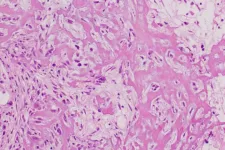(Press-News.org) WASHINGTON, January 26, 2021 -- As the pandemic has continued to spread globally, studies indicate the COVID-19 virus may be contained in aerosols that can be generated and spread through breathing, coughing, sneezing, or talking by infected individuals. Researchers are increasingly focused on developing tools and methods to assist in decontaminating surfaces and spaces.
While scientists have previously explored the use of electromagnetic energy to deactivate flu virus in bulk fluids, less work has been done to understand the role of nonionizing radiation, such as microwaves, in reducing the infectivity of viral pathogens in aerosols. The tools required to both safely contain contaminated aerosol streams and expose these aerosols to controlled, well-characterized microwave doses have not been readily available.
In Review of Scientific Instruments, by AIP Publishing, researchers from the Air Force Research Laboratory report development of a set of experimental tools capable of presenting electromagnetic waves to an aerosol mixture of biological media and virus with the capability to vary power, energy, and frequency of the electromagnetic exposure. The researchers seek to better characterize the threshold levels of microwave energy needed to inactivate aerosolized viral particles and, thus, reduce their ability to spread infection.
"In this way, we believe our experimental design is capable of a fundamental investigation of a wide variety of inactivation mechanisms. This range of capability is especially important given the range of potential interaction mechanisms found in the literature," said co-author John Luginsland.
The key portions of each system fit within standard biosafety cabinets, ensuring multiple layer containment of pathogens. Additionally, the systems are designed to prevent release of microwave radiation into the laboratory environment, which, at elevated levels, could potentially interfere with diagnostic equipment and other electronics.
During initial experiments, the AFRL researchers are exposing a human-safe coronavirus surrogate, bovine coronavirus, to a range of microwave waveforms at frequencies ranging from 2.8 GHz to 7.5 GHz.
"The bovine coronavirus is similar in size and configuration to human coronavirus but is safe to humans," said co-author Brad Hoff.
If exposure to microwaves is demonstrated to be sufficiently effective in reducing infectivity, experimental efforts could then proceed to use aerosols containing COVID-19 coronavirus or other human-infecting pathogens.
"If shown to be effective, the use of microwaves may enable the potential for rapid decontamination not currently addressed by ultraviolet light or chemical cleaning for highly cluttered areas, while potentially operating at levels safely compatible with human occupancy," said Hoff.
INFORMATION:
The article "Apparatus for controlled microwave exposure of aerosolized pathogens" is authored by Brad W. Hoff, Jeremy W. McConaha, Zane Cohick, Matthew A. Franzi, Daniel A. Enderich, David Revelli, Jason Cox, Hammad Irshad, Hugh Pohle, Andreas Schmitt-Sody, Samuel C. Schaub, Anthony E. Baros, Naomi C. Lewis, John W. Luginsland, Michael T. Lanagan, and Steven Perini. The article will appear in Review of Scientific Instruments on Jan. 26, 2021 (DOI: 10.1063/5.0032823). After that date, it can be accessed at https://aip.scitation.org/doi/10.1063/5.0032823.
ABOUT THE JOURNAL
Review of Scientific Instruments publishes novel advancements in scientific instrumentation, apparatuses, techniques of experimental measurement, and related mathematical analysis. Its content includes publication on instruments covering all areas of science including physics, chemistry, materials science, and biology. See https://aip.scitation.org/journal/rsi.
What The Study Did: Survey data from school-age children and adolescents in Guangdong province, China, were used to assess self-reported psychological distress associated with the COVID-19 pandemic.
Authors: Chichen Zhang, M.D., and Ruibin Zhang, Ph.D., of Southern Medical University in Guangzhou, and Xuefeng Yi, M.D., of the Health Publicity and Education Center of Guangdong Province, all in China, are the corresponding authors.
To access the embargoed study: Visit our For The Media website at this link https://media.jamanetwork.com/
(doi:10.1001/jamanetworkopen.2020.35487)
Editor's Note: The article includes funding/support disclosures. ...
Exposure to antibiotics in the first days of life is thought to affect various physiological aspects of neonatal development. A new study, led by Bar-Ilan University's Azrieli Faculty of Medicine, reveals that antibiotic treatment within 14 days of birth is associated with reduced weight and height in boys - but not girls -- up to the age of six.
By contrast, the study showed significantly higher body mass index (BMI) in both boys and girls following antibiotic use after the neonatal period, and within the first six years of life.
The findings, published in the journal Nature Communications ...
WASHINGTON, January 26, 2021 -- The positions of air inlets and outlets in confined spaces, such as elevators, greatly affect airborne virus transmission. In Physics of Fluids, by AIP Publishing, researchers from University of Nicosia in Cyprus show while air purifiers would be expected to help, they may actually increase the spread.
Air quality in small spaces can quickly degrade without ventilation. However, adding ventilation will increase the rate at which air, possibly laden with viruses, can circulate in the small space. Elevator manufacturers have added air purifiers to take care of ...
An innovative approach to treating bone tumors - starving cancer cells of the energy they need to grow - could one day provide an alternative to a commonly used chemotherapy drug without the risk of severe side effects, suggests a new study from Washington University School of Medicine in St. Louis. Studying human cancer cells and mice, the researchers said that a two-drug combination targeting a tumor's energy sources could be as effective and less toxic than methotrexate, a long-used chemotherapy drug often given in high doses to treat osteosarcoma, a bone cancer.
The study appears Jan. 26 in the journal Cell Reports.
Osteosarcoma is ...
PITTSBURGH, Jan. 26, 2021 - The mechanism by which acute viral respiratory infections promote secondary bacterial growth and infection in the airways depends on iron-carrying extracellular sacs secreted by the cells lining the host's airways, report researchers from the University of Pittsburgh School of Medicine in a paper published today in Cell Reports.
The sacs, or "vesicles," which carry iron bound to a protein called transferrin, associate with bacterial cells and supply them with essential nutrients, promoting the growth of expansive bacterial communities. The finding gives us a glimpse into how bacteria ...
Although the protein ITIH4 is found in large amounts in the blood, its function has so far been unknown. By combining many different techniques, researchers from Aarhus University have discovered that ITIH4 inhibits proteases in the innate immune system via an unknown mechanism. The research results have just been published in the prestigious scientific journal Science Advances.
Proteases are enzymes that cleave other proteins. Most often, proteases occur in cascade networks, where a particular event triggers a chain reaction in which several proteases cleave and thereby activate each other. Most well known is probably the coagulation cascade, which causes clotting of our blood when a vessel is punctured.
But a similar network of proteases called the complement ...
There are an estimated 40,000 to 50,000 species of micro-organism per gram of soil. Addition of certain microbes can tailor soil characteristics: removing contaminants, improving fertility and even making barren land available for farming.
The Microbiology Society's report calls for increased access to research into soil health, promoting outreach activities in agricultural colleges and schools and showcasing work in non-academic outlets. This, say microbiologists, is the best way to collaborate with farmers to improve soil health and agricultural productivity.
Tilling and excessive use of fertilisers have major effects on soil health. Microbiology can be used to help understand the impact of intensive farming and design feasible mitigation practices.
The report ...
Authors from the German Center for Diabetes Research (DZD) presented data showing that the longevity gene mammalian Indy (mINDY) is involved in blood pressure regulation in the Journal of Clinical Investigation (JCI) insight. Reduced expression of mINDY, which is known to extend life span in lower organisms and to prevent from diet induced obesity, fatty liver and insulin resistance in mice, has now been shown to lower blood pressure and heart rate in rodents. The authors provided mechanistic insights for the underlying physiological mechanism based on in vivo data in a genetic knock out model as well as microarray and in vitro studies. Furthermore, ...
Children determine emotion by what they hear, rather than what they see, according to new research.
The first-of-its-kind study, by Durham University's Department of Psychology, looked at how children pick up on the emotions of a situation.
They found that whilst adults prioritised what they see, young children showed an auditory dominance and overwhelmingly prioritised what they could hear.
The researchers say their findings could benefit parents currently managing home learning and professional educators by increasing their understanding of how young children pick up on what is going on around them.
The research may also provide new avenues to understanding ...
Theories were introduced as far back as the 1960s about the possible existence of superheavy elements. Their most long-lived atomic nuclei could give rise to a so-called "island of stability" far beyond the element uranium. However, a new study, led by nuclear physicists at Lund University, shows that a 50-year-old nuclear physics manifesto must now be revised.
The heaviest element found in nature is uranium, with a nucleus containing 92 protons and 146 neutrons. The nuclei of heavier elements become more and more unstable due to the increased number of positively charged protons. They therefore decay faster and faster, usu-ally within a fraction of a second. ...



